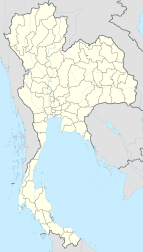Site Two Refugee Camp
| Site Two | |
|---|---|
| Refugee camp | |
| Location in Thailand | |
| Coordinates: 14°04′59″N 102°54′55″E / 14.08306°N 102.91528°ECoordinates: 14°04′59″N 102°54′55″E / 14.08306°N 102.91528°E | |
| Country |
|
| Opened by the Royal Thai Government | January, 1985 |
| Area | |
| • Total | 7.5 km2 (2.9 sq mi) |
| Population (1989) | |
| • Total | 198,000 |
| • Density | 26,400/km2 (68,000/sq mi) |
Site Two Refugee Camp (also known as Site II or Site 2) was the largest refugee camp on the Thai-Cambodian border and, for several years, the largest refugee camp in Southeast Asia. The camp was established in January 1985 during the 1984-1985 Vietnamese dry-season offensive against guerrilla forces opposing Vietnam's occupation of Cambodia.
Site Two was closed in mid-1993 and the great majority of its population was voluntarily returned to Cambodia.
In early 1985 the Royal Thai Government, together with the United Nations Border Relief Operation (UNBRO) and other UN agencies, decided to resettle populations displaced from refugee camps that had been destroyed by military activity into a single camp where aid agencies could provide combined services. Site Two was located in Thailand 70 kilometers northeast of Aranyaprathet, near Ta Phraya, approximately 4 kilometers from the Cambodian border.
The camp covered 7.5 square kilometres (2.9 sq mi) and combined the populations of Nong Samet (Rithysen), Bang Poo (Bang Phu), Nong Chan, Nam Yeun (a camp located on the eastern Thai-Cambodian border, near Laos), Sanro (Sanro Changan), O'Bok, Ban Sangae (Ampil), and Dang Rek (Dong Ruk)[1] camps, all of which had been displaced by fighting between November 1984 and March 1985. These camps supported the non-communist resistance spearheaded by Son Sann's Khmer People's National Liberation Front (KPNLF). However, Site Two was intended as a civilian camp and the Khmer People's National Liberation Armed Forces (KPNLAF) were based in other locations.
...
Wikipedia

